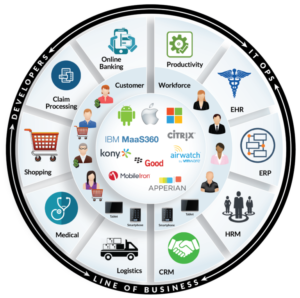Mobile Alphabet Soup – How Mobile APM Augments Enterprise Mobility Management
 The Enterprise Mobility Management (EMM) market has changed rapidly, as enterprises focus on mobile apps to increase customer satisfaction and workforce productivity. With this trend, Mobile APM (Application Performance Monitoring) products have evolved to augment EMM solutions in important ways.
The Enterprise Mobility Management (EMM) market has changed rapidly, as enterprises focus on mobile apps to increase customer satisfaction and workforce productivity. With this trend, Mobile APM (Application Performance Monitoring) products have evolved to augment EMM solutions in important ways.
Get out your mobile scrabble tiles and bingo cards, as we cover some background! Although many mobility programs exist, they have similar management requirements. Bring Your Own Device (BYOD), Choose Your Own Device (CYOD), and Corporate Owned Personally Enabled (COPE), all require the enterprise to develop policies that treat corporate mobile apps separately from the personal apps that employees run on their devices.
In response, the lines have blurred between Mobile Device Management (MDM) and Mobile Application Management (MAM) products. Vendors have expanded their product portfolios to provide more fine-grained control of mobile apps.
At the same time, Mobile App Development Platform (MADP) products have extended into MAM. This enables their customers to develop and manage mobile apps through the lifecycle, but also to provision and deploy them to the workforce.
Enterprise Mobility Management is only a start to achieving your mobility goals

What can get lost in this mobile alphabet soup is how EMM vendors enable customers to achieve the strategic goals of their mobility initiatives—to raise customer satisfaction and workforce productivity.
MDM products enable enterprises to provision, register, configure, and inventory mobile devices. With MDM solutions, enterprises set device-wide security policies, like user authentication and password policies. They can also remotely wipe a device if it gets lost. In addition, MDM solutions enable enterprises to provision bundles of software to devices, and set policies for updates, change control, and data protection.
With MAM products, enterprises distribute mobile apps through private or hosted app stores. MAM products provide app wrapping and containerization to allow policies for security, configuration, and provisioning to be set separately for individual apps, and for different user groups. They enable enterprises to manage the application life cycle through new versions, patches, and upgrades.
MADP vendors have begun to provide these same MAM capabilities as add-ons to their development and QA platforms.
Developing, provisioning, configuring, inventorying, and securing devices and applications are necessary first steps for enterprise mobility initiatives. However, by themselves, they don’t enable enterprises to improve customer satisfaction and workforce productivity.
Achieving enterprise mobility goals requires mobile APM
EMM vendors provide metrics and analytics associated with their domain expertise. MDM products provide analytics at the device level, but have a limited view of app usage and performance, and only basic user information. MAM products app provisioning analytics, but have limited insight into the app’s actual usage and performance on the user’s device.
Enterprises have recognized the need to augment these capabilities with the ability to monitor mobile end user experience. Mobile APM vendors have responded accordingly, with products that provide mobile app developers with crash analytics, app error reporting, and service performance metrics.
Mobile APM for consumer AND workforce mobile apps
 As important as these mobile APM capabilities are, they primarily solve problems for consumer-facing apps. Most mobile APM products lack visibility into important aspects of the enterprise end user—their identity, role, and business function, the full range of apps and devices they use, and the business activities for which employees are responsible.
As important as these mobile APM capabilities are, they primarily solve problems for consumer-facing apps. Most mobile APM products lack visibility into important aspects of the enterprise end user—their identity, role, and business function, the full range of apps and devices they use, and the business activities for which employees are responsible.
Workforce mobile apps, such as productivity apps, ERP, CRM, and EHR, require capabilities beyond those which mobile APM products provide to app developers. For IT Ops to prioritize their response to an incident, they need to understand the business impact, functional organization and business locations of impacted users. In addition, they need to know whether desktop users are also impacted.
The line of business must determine whether or not mobile is improving workforce productivity. Therefore, they need capabilities more meaningful than crash analysis, stack trace, breadcrumbs, and handled exceptions. To succeed, they need metrics that are relevant to the business, such as the time to required to fill out a claim form, or the number of orders processed in a remote office.
How SteelCentral Mobile APM augments your EMM solution
SteelCentral Mobile APM picks up where other mobile APM vendors leave off. SteelCentral addresses the full range of mobile APM use cases for developers of mobile enterprise apps, IT Ops who support them, and the line of business who rely on them to transform their markets. To see for yourself, watch this short video to get a look at SteelCentral Mobile APM in action.
Get started with SteelCentral Mobile APM today
The success of your mobile strategy depends on ensuring an excellent mobile end user experience. With SteelCentral, you can ensure a “five star” user experience for all of the business critical apps in your portfolio—local, web, cloud, or mobile. Your operations team can use the same workflow, processes, and product to manage EVERY type of business critical app. That means faster troubleshooting, fewer hand-offs, better IT efficiency, and better digital experience—for your customers and your workforce. Your app owners and business execs can track the impact of mobile apps on workforce productivity and customer service. Read the SteelCentral Mobile APM solution brief to learn more.
 Or better yet, get instant access to Aternity in our cloud environment and explore the Mobile APM use case yourself!
Or better yet, get instant access to Aternity in our cloud environment and explore the Mobile APM use case yourself!
For a deep dive introduction to our solutions, check out our on demand webinar on Mobile APM.
